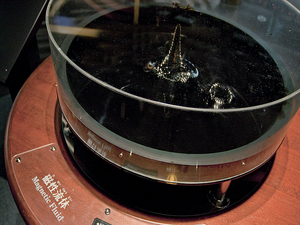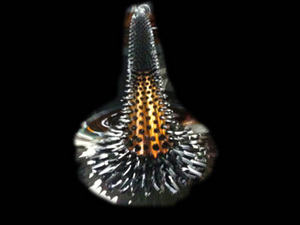Nagoya City Science Museum
TOP > Exhibition Guide > Keyword Search > Starting with "E" > electromagnet > Magnetic Fluid
Magnetic Fluid



Purpose of Exhibition
In this exhibit, you can experience a magnetic fluid that sticks to magnets. While enjoying the beautiful structures produced by the magnetic field, you can consider the use of the fluid which reacts to the magnet.
Additional Knowledge
[What is a magnetic fluid?]
It is a fluid that sticks to a magnet.
In the 1960s NASA exploited its use in order to control the transfer of liquid fuels used in rockets; its properties were used in the rotation axis seal, dampers and speakers.etc. Because it behaves as a fluid while attracting magnets as strong as steel.
[Rotation Axis seal]
Magnetic fluid is used to prevent dust and gas from entering and leaving along the rotation axis, for example, when gases are packed in a container, and when you install a rotating handle to operate objects in the container. It also prevents gas from escaping along the handle axis.
A method became available for magnetic fluid seals use at that time. By placing a magnet around the rotation axis, the magnetic fluid stays between the axis and the bearing.
Even if the axis rotates, gas and dust do not come in or out. Because the magnetic fluid is a fluid, it does not separate from the axis.
[Damper]
A damper is a device that absorbs vibrations and shocks. When a car is traveling over different surface levels, springs play a role in avoiding transmission shock in the car. With springs only, vibration continues in the car, because springs have a tendency to continually vibrate. And so the car is unstable, and you might feel uncomfortable as if you were in a floating vehicle while riding.
Therefore, some devices called shock absorbers or dampers are attached to absorb shocks and vibrations of the springs. Generally, a damper uses oil and air etc. but you can change the amount of vibration absorbed by the use of magnetic fluid. When applying a magnetic field, there may be increase of the viscosity of the magnetic fluid. If the viscosity changes, vibration absorption changes . According to the circumstances at that moment, by changing the magnetic fluid, you can create the damper by means of the magnetic fluid, changing the extent of vibration and shock absorbtion.
[Structure of magnetic fluid]
A magnetic fluid is made of three things: [Magnetic fluid particles], [Surfactant] and [Base fluid].
[Magnetic fluid particles]
Ferromagnetic materials are magnetized substances such as iron and nickel that become magnets. In magnetic fluid, ferrite particles such as magnetite and ferrite particles, whose diameters are about 10nm, are used. It is due to the ferrite particles' reaction to magnets that magnetic fluid attracts magnets.
[Surfactant]
Surfactant is a major component of detergents.
It has both characteristics to easily infiltrate water and oil.
Oil can be removed by detergent because surfactant easily infiltrates oil and sticks to it while it easily infiltrates water and is dissolved in it.
In the magnetic fluid, the surfactant wraps up the ferromagnetic particles. Therefore, it prevents the particles from sticking together, and they penetrate the base liquid.
The magnetic fluid wraps up ferromagnetic particles of the surfactant, thereby preventing particles from sticking together, and blending them into the base liquid.
In addition, it prevents the particle from sinking to the bottom of the base fluid becauseof the action of the surfactant.
[Base fluid]
A water-based or oil-based solution is used, depending on the purposes.
[Spiking phenomenon]
When magnetic fluid comes closer to a magnet, the shape changes and appears as if many thorns are lined up. This is what we call a "spiking phenomenon". When magnetic fluids gather along the line of magnetic force, this form appears due to reaction between magnetic fluids.
Artistic works are created by using this spiking phenomenon.
Article by Yoshitaka Yamada, curator
